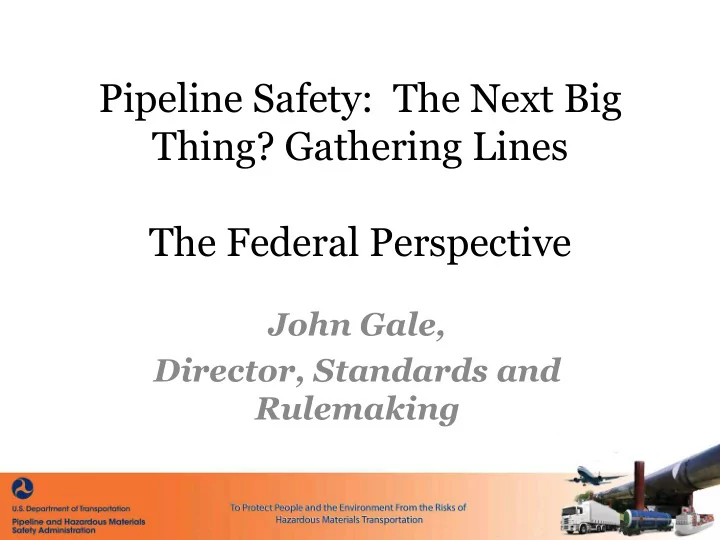

Pipeline Safety: The Next Big Thing? Gathering Lines The Federal Perspective John Gale, Director, Standards and Rulemaking
Existing Gas Gathering Regulations • Gas vs Hazardous liquid gathering • PHMSA currently regulates Gas Gathering lines in Class 2, 3 and 4 locations • PHMSA does not currently regulate gas gathering lines in Class 1 locations (rural) – Very State specific issue • PHMSA believes that high pressure large diameter gas gathering pipelines should be subject to a minimum set of regulations and that appropriate data should be collected in order to inform future decision making
Class Locations 1 to 4 Class 1 Class 3 Class 4 Class 2 - 3 -
Regulated Gas Gathering Mileage by Class Location Facility Class 1 Class 2 Class 3 Class 4 Total Type Onshore NA 5,616 2,665 7 8,288 Type A Onshore NA 1,677 1,670 26 3,373 Type B Offshore 6,183 NA NA NA 6,183 Total 6,183 7,293 4,335 33 17,845 2018 Gas Transmission and Gas Gathering Annual Report NA – not applicable
Gas Gathering Estimate of Unregulated Mileage Gas Gathering – Unregulated – Total PHMSA Estimate – through 2018 Miles Current Estimate 426,109 Gas Gathering - (high stress, ≥ 8.625”) Proposed in Rulemaking– 2018 Estimate ≥ 8.625" to 12.75" > 12.75" to Total Diameter > 16" < 12.75" ≤ 16" Miles Estimate 46,094 19,665 12,604 12,500 90,863 through 2018
What changed? q Unconventional vs conventional drilling q Conventional drilling - smaller diameter, lower pressures pipelines. q Low risk in Class 1 (rural areas) q Unconventional drilling – larger diameter high pressure lines q Present a higher risk even in Class 1 (rural areas) - 6 - - 6 -
What is PHMSA doing to address this next big thing? • In 2006 PHMSA published a final rule reshaping the gas gathering regulations • In 2006, unconventional drilling begins in earnest • In 2011 initiated a rulemaking addressing a variety of gas pipeline safety issues, including gas gathering lines 7
What is PHMSA doing to address this next big thing? • In 2016, PHMSA published an NPRM proposing to: – Regulate high pressure gas gathering lines 8 inches in diameter and greater. – Collect annual reports and incident data for all 400,000 plus miles of gas gathering lines – Revised definitions related to gas gathering lines 8
Existing Gas Gathering Regulations • Current Safety Requirements for Regulated Onshore Gas Gathering below 20% SMYS (Type B) (1) If new, or replaced - Construction of Part 192 (2) If metallic, control corrosion requirements of Part 192 (3) Damage prevention program under § 192.614; (4) Public awareness program under § 192.616; (5) Establish the MAOP of the line under § 192.619; (6) Install and maintain line markers per § 192.707; (7) Leakage surveys in accordance with § 192.706 using and promptly repair hazardous leaks per § 192.703(c); (8) Emergency plans § 192.615.
What is PHMSA doing to address this next big thing? • In 2019, Gas Pipeline Advisory Committee met to discuss PHMSA proposal and recommended that PHMSA: – Regulate high pressure gas gathering lines 8 inches in diameter and greater. – Collect annual reports and incident data for all 400,000 plus miles of gas gathering lines 1 0
Current Rulemakings in Process Safety of Gas Gathering Lines (Final Rule stage) q NPRM published 4/8/2016 Comment period closed 7/7/2016 • Split from original Gas Transmission NPRM • GPAC meeting held June 2019 • q Major Topics under consideration: Revision to the definitions for gas gathering (production, gathering, incidental § gathering, elimination of RP 80 reference) Data collection for all gas gathering lines (including unregulated gas gathering): § Annual reporting and Incident Reporting Appropriate regulations large diameter-high pressure lines and establish § minimum set of requirements for pipelines 8.625 inches in diameter and greater - 11 - - 11 -
Conclusion • Who has to be involved to address this Next Big Thing? – Federal Government – States – Industry – Public - 12 - - 12 -
. Thank you!! - 13 -
Recommend
More recommend